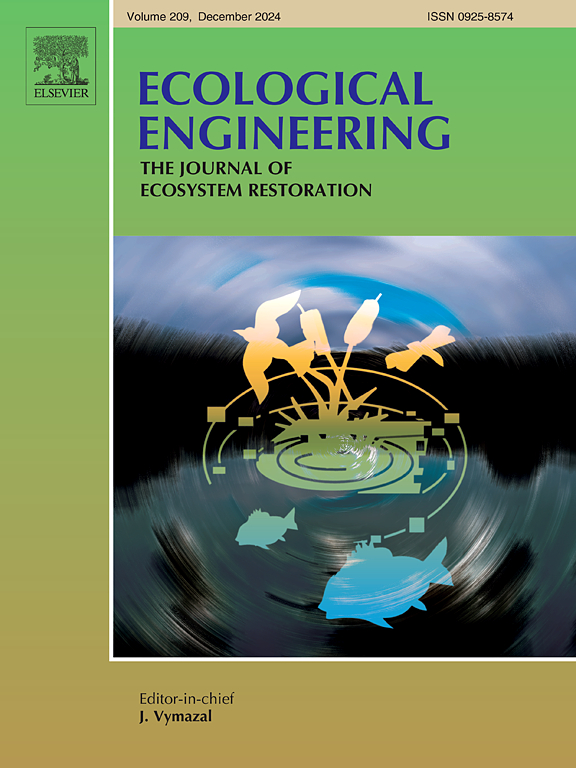Quantitative analysis of landslide impact on vegetation: Insights from field surveys and UAV imagery
IF 3.9
2区 环境科学与生态学
Q1 ECOLOGY
引用次数: 0
Abstract
Deep-seated landslides can have significant and long-lasting impacts on surrounding ecosystem by altering topography and destabilizing the ground. This study presents a quantitative investigation of the impacts of deep-seated landslides, which have actively supplied sediments for more than one hundred years, on damaged trees, incorporating various factors such as distance from landslide borders, slope gradient, factor of safety (FS), Wind Exposure Index (WEI), Convergence Index, and plan curvature in four landslides in Japan (Shichimenzan, Senmai, Sarugare, and Akakuzure). The study aims to enhance our understanding of the relationship between landslides and vegetation, providing valuable insights for landslide management and ecological restoration. Using a combination of field surveys and high-resolution UAV (Unmanned Aerial Vehicle) images from 2020 and 2023, a total of 2057 damaged trees were identified across all four study landslide areas. Statistical analysis (One-Way ANOVA) show there is significant differences among different damaged tree types in studied variables in 99 % of confidence level. Analysis of the distance from landslide borders revealed significant differences among damaged tree types. The average distance of Fallen and Green (FG) trees from the landslide borders was found to be 7.3 m, indicating their proximity to the affected area. Furthermore, the density of FG trees within the expanded area of the landslide was observed to be higher. Stand and Dead (SD) trees, in contrast, were situated at an average distance of 68.6 m from landslide border, suggesting their vulnerability to animal-related damages. Fallen and dead (FD) trees were associated with steep slope gradients, averaging 40.8 degrees, and exhibited low FS values (0.87), indicating their susceptibility to slope instability. Stand and Dead partially trees (SDP) and SD trees demonstrated higher FS values suggesting their presence in areas with superior slope stability. In addition, results show, FG, SD, and SDP trees were predominantly located in wind-exposed higher elevation areas. FD trees were primarily situated in areas with negative Convergence Index values (−0.7), indicating slope convergence. FG and SDP trees were found in areas with positive values, suggesting slope divergence. The findings enhance our understanding of the complex and long-lasting landslide impacts on forests, informing landslide management and ecological restoration strategies.

滑坡对植被影响的定量分析:来自野外调查和无人机图像的见解
深层滑坡可以通过改变地形和破坏地面稳定,对周围生态系统产生重大而持久的影响。本研究结合与滑坡边界的距离、坡度、安全系数(FS)、风暴露指数(WEI)、收敛指数(Convergence Index)和平面曲率等多种因素,对日本四个滑坡(石门山、森脉、Sarugare和赤秋)的深层滑坡对受损树木的影响进行了定量调查,这些滑坡积极提供了一百多年的沉积物。该研究旨在加深我们对滑坡与植被关系的认识,为滑坡管理和生态恢复提供有价值的见解。利用2020年和2023年的实地调查和高分辨率无人机(UAV)图像相结合,在所有四个研究滑坡区域共确定了2057棵受损树木。统计分析(One-Way ANOVA)显示,不同受损树种间研究变量在99%的置信水平上存在显著差异。与滑坡边界的距离分析显示,不同受损树种之间存在显著差异。落叶树与滑坡边界的平均距离为7.3 m,表明其与受灾地区的距离较近。此外,在滑坡扩展区域内,FG树的密度更高。相比之下,立木和枯树(SD)距离滑坡边界的平均距离为68.6米,表明它们容易受到动物相关的损害。倒下和死亡树木(FD)与陡峭的坡度相关,平均为40.8度,FS值较低(0.87),表明它们对边坡失稳的敏感性。立木、部分枯死树(SDP)和部分枯死树(SD)的FS值较高,表明它们存在于边坡稳定性较好的地区。此外,结果表明,FG、SD和SDP树主要分布在风暴露的高海拔地区。FD树主要分布在收敛指数为负(- 0.7)的区域,即斜率收敛。FG树和SDP树出现在正值区域,表明坡度发散。这些发现增强了我们对滑坡对森林的复杂和长期影响的理解,为滑坡管理和生态恢复策略提供了信息。
本文章由计算机程序翻译,如有差异,请以英文原文为准。
求助全文
约1分钟内获得全文
求助全文
来源期刊

Ecological Engineering
环境科学-工程:环境
CiteScore
8.00
自引率
5.30%
发文量
293
审稿时长
57 days
期刊介绍:
Ecological engineering has been defined as the design of ecosystems for the mutual benefit of humans and nature. The journal is meant for ecologists who, because of their research interests or occupation, are involved in designing, monitoring, or restoring ecosystems, and can serve as a bridge between ecologists and engineers.
Specific topics covered in the journal include: habitat reconstruction; ecotechnology; synthetic ecology; bioengineering; restoration ecology; ecology conservation; ecosystem rehabilitation; stream and river restoration; reclamation ecology; non-renewable resource conservation. Descriptions of specific applications of ecological engineering are acceptable only when situated within context of adding novelty to current research and emphasizing ecosystem restoration. We do not accept purely descriptive reports on ecosystem structures (such as vegetation surveys), purely physical assessment of materials that can be used for ecological restoration, small-model studies carried out in the laboratory or greenhouse with artificial (waste)water or crop studies, or case studies on conventional wastewater treatment and eutrophication that do not offer an ecosystem restoration approach within the paper.
 求助内容:
求助内容: 应助结果提醒方式:
应助结果提醒方式:


